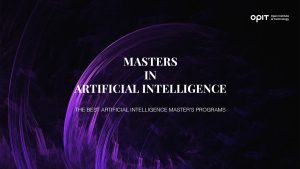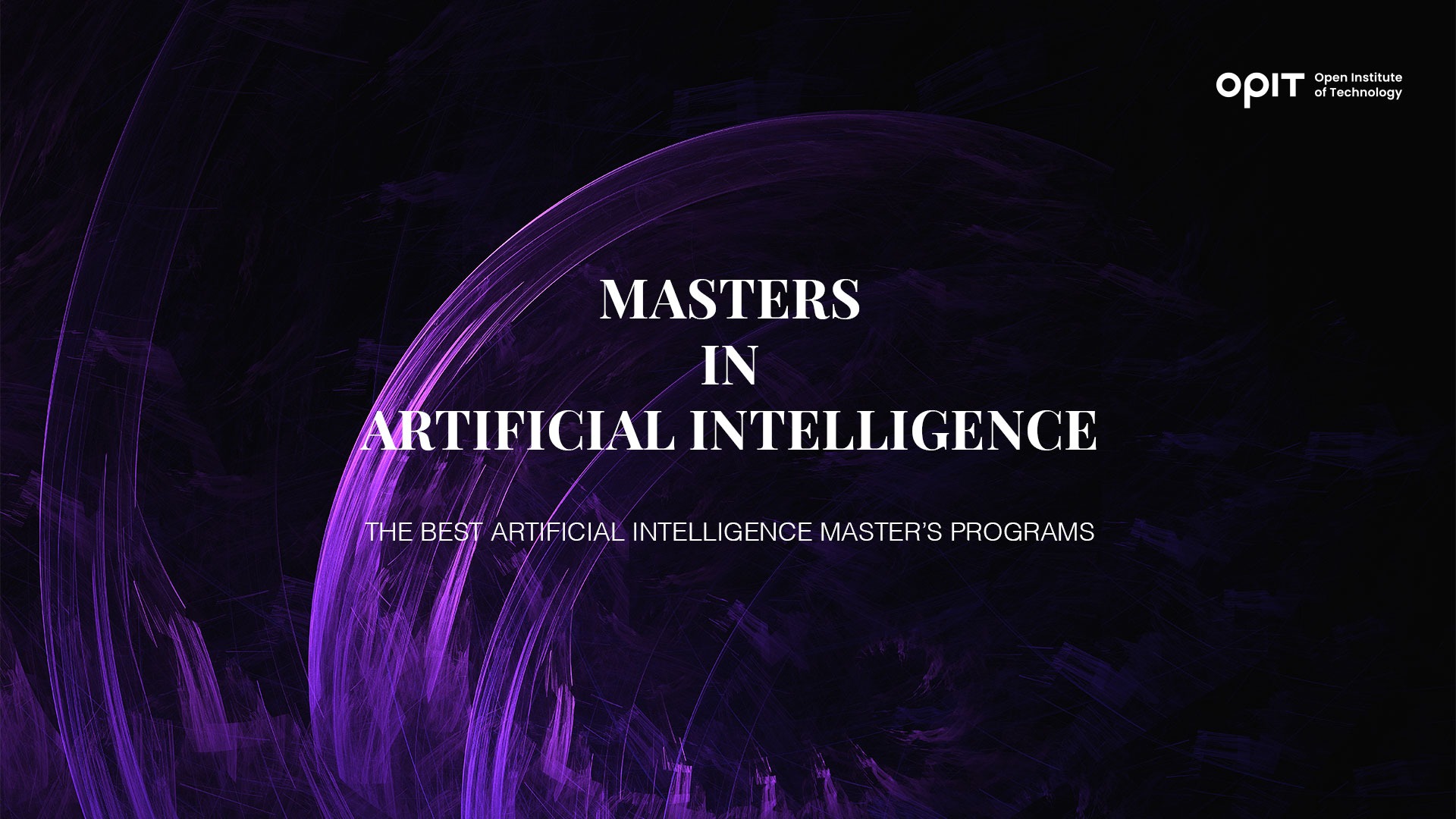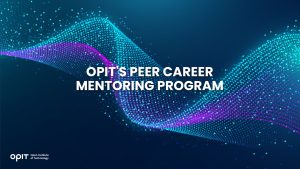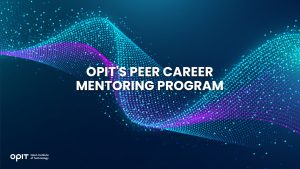

AI and machine learning are like an unstoppable tidal wave in today’s world. We’ve already seen the crest of that wave appear over the horizon with increased automation in businesses and the emergence of apps like ChatGPT. But in the coming years, the wave will engulf the world, making AI big business.
That’s supported by statistics from Statista, too, with reports that the AI market that was worth $200 billion (approx. €185 billion) in 2022 will be worth a staggering $2 trillion (approx. €1.85 trillion) in 2030. The point is that massive growth is coming in AI, and the right Master’s in AI is the key for you to be a part of that growth rather than getting stuck in an industry that gets consumed by it.
Top European Programs for Masters in AI and ML
In choosing the MSc artificial intelligence programs that appear on this list, we looked at factors ranging from the quality (and variety) of course content to who provides the degree. The three courses highlighted here are among Europe’s best to offer to European and overseas students.
Master in Artificial Intelligence (Universita di Bologna)
Though it’s held in Italy, this Master’s program is delivered in English as part of Universita di Bologna’s computer science program. It’s an on-campus course, meaning you’ll have to move to Bologna to attend.
The course provides a solid grounding in the foundations of AI over two years. You’ll get to grips with topics like machine learning and natural language processing, in addition to touching on the ethical and social issues that the rise of AI brings to the table.
The course is welcoming to international students, as it currently has a 77% ratio of international students who don’t come from Bologna. To apply, you must complete an application on the Studenti Online program, along with a mandatory form. Failure to follow this procedure leads to your application being discarded. Applicants don’t necessarily need to hold a Bachelor’s degree, though they must demonstrate a transcript of record that shows they have earned at least 150 ECTS or CFU credits in majors like computer science, mathematics, statistics, and physics.
The course page boasts that 90.5% of its 2021 graduates were happy with their degrees. It’s natural to assume most of these graduates leveraged their Master’s in artificial intelligence to move into careers in the field.
Master in Applied Data Science & AI (OPIT)
If you want to master artificial intelligence with a sprinkling of applying that mastery to the data science industry, OPIT’s course is right for you. It’s an 18-month course (though a 12-month fast-track version is available) that is fully online and delivers 90 ECTS credits. The first term covers the foundational aspects of AI, including subjects like machine learning and data science. But the second term stands out as it moves study from the theoretical to the practical by challenging you to solve real-world problems with your knowledge.
As an online program, it’s available to anybody anywhere, with entry requirements also being flexible. You’ll need a BSc degree, even one from a non-technical field, and should demonstrate English proficiency up to the B2 level with appropriate certification. Don’t worry if you don’t have an English language certification because OPIT offers its own that you can take before registering for the course.
Career-wise, the course is a good option because it occupies an interesting middle-ground between theory and practicality. The second term, in particular, equips you with skills that you can apply directly in fields as varied as IT business analysis, business intelligence, and data science.
MSc in Advanced Computer Science (University of Oxford)
Though it’s not marketed directly as a Master’s in machine learning and artificial intelligence, the University of Oxford’s program gives you excellent qualifications in both. It’s also delivered by an institution that EduRank names as the best for AI in the UK, and sixth-best in the world. The course examines advanced machine learning and computer security techniques, focusing on computational models and the algorithms behind them.
It’s a full-time program demanding 35 hours of weekly study, 15 of which you’ll spend on campus with the other 20 dedicated to self-study. It’s also a tough nut to crack for applicants, as the University of Oxford has a low 18% acceptance rate. You’ll need a first-class undergraduate degree with honors (or an equivalent) in mathematics or computer science to stand a chance of getting into one of the UK’s most prestigious universities.
Those tough entry requirements pay off later on, though, as the words “University of Oxford” on a CV immediately make employers stand up and pay attention. The wide-ranging approach of the program also means you’re not focusing solely on AI, opening up career opportunities in other fields related to math and statistical analysis.
Data Science Master – Europe’s Best Options
Data science is an industry that requires you to translate your understanding of algorithmic theory to transform complex data sets into actionable insights. It’s also an industry that’s making increasingly heavy use of AI tools, making a Master’s in data science a great companion (or alternative) to the best artificial intelligence Master in Europe. As you noticed above, OPIT’s MSc AI program includes elements of data science, though the two programs here (covered in brief) are excellent choices as standalone programs.
MSc Data Sciences and Business Analytics (Essec Business School)
This hybrid course lasts for either one or two years, depending on your background, and focuses on the application of data sciences in a business context. It’s also ranked as the fourth-best Master’s in business analytics in the world by QS World University Rankings.
That high ranking is backed up by the university’s own statistics, which state that over half of its students get jobs before they even complete the course. Essec has a 100% career success rate for graduates in less than six months from completion of the Master’s, making this a great choice for career-focused students. Google, Amazon, JP Morgan Chase, and PwC count as some of the top recruiters that keep their eye on graduates from this program.
Admission requires a degree in a related technical subject, such as engineering, science, or business, from a leading university. That degree also impacts the version of the program you take, as a three-year BSc means you take the two-year Master’s, while those who have a four-year BSc under their belts take the one-year version, assuming they meet other requirements.
Data Science, Technology, and Innovation (University of Edinburgh)
With over 13,000 international students, the University of Edinburgh welcomes overseas students who want to expand their knowledge. Its MSc data science program is no different, buoyed by the fact that it’s an online course that doesn’t require you to move to the less-than-sunny climate of Edinburgh.
It’s a part-time program that relies on self-study, though it provides you with plenty of interactive resources to help along the way. The program is something of an umbrella course as it focuses on equipping students with the knowledge they need to enter the data science field across industries as diverse as medicine, science, and even the arts.
You’ll need the equivalent of an Upper Second-Class Honors degree that has elements of programming before applying. Ideally, you’ll also have evidence of mathematical skill, either through taking math classes in your undergraduate studies or by demonstrating the equivalent of an English A-Level in math through other qualifications.
Factors to Consider When Choosing an Artificial Intelligence Master’s
The five programs highlighted here all help you master artificial intelligence, with many also providing a practical grounding that puts you in good stead for your future career. But if you want to do more research (and that’s always a good idea), the following factors should be on your mind when checking other programs:
- Course Curriculum – The content of your course impacts what you can do once you have your MSc under your belt. Focus on programs that teach tangible skills applicable to the field you wish to enter.
- Faculty – Always check the credentials of the program’s creators and administrators, particularly in terms of industry experience, to confirm they have the relevant tools.
- Tuition and Financial Aid – Master’s programs aren’t cheap (you’ll pay several thousand euros for even an online course), so check you can budget accordingly for the program. Many universities offer financial aid options, from scholarships to student loans, that can help in this area.
- Location – The location isn’t really an issue if you take an online course, but it impacts your decision if you decide to study on-campus. Remember that you’ll spend at least a year of your life on the course (often two years) so you need to gel well with the place in which you’ll live.
- Networking and Industry – Does the course provider have connections to major industry players? Does it offer career advice, ideally via a specialized office or program? These are the types of questions to ask when assessing a university’s capacity for networking and career advancement.
Become a Master in Artificial Intelligence
A Master’s degree in artificial intelligence is your entry point into a growing industry that’s already on the verge of taking the world by storm. That is, assuming you choose the right program. The five highlighted here all land in the “right program” category by virtue of the tuition you receive, the reputation of the institution, and their accessibility to European and overseas students.
Research each program (and any others you consider) extensively before making a choice. Remember that it’s not always about the course or its reputation – it’s about how the course helps you achieve the specific learning goals you need to achieve to get ahead in your chosen career.
Related posts

Source:
- Raconteur, published on November 06th, 2025
Many firms have conducted successful Artificial Intelligence (AI) pilot projects, but scaling them across departments and workflows remains a challenge. Inference costs, data silos, talent gaps and poor alignment with business strategy are just some of the issues that leave organisations trapped in pilot purgatory. This inability to scale successful experiments means AI’s potential for improving enterprise efficiency, decision-making and innovation isn’t fully realised. So what’s the solution?
Although it’s not a magic bullet, an AI operating model is really the foundation for scaling pilot projects up to enterprise-wide deployments. Essentially it’s a structured framework that defines how the organisation develops, deploys and governs AI. By bringing together infrastructure, data, people, and governance in a flexible and secure way, it ensures that AI delivers value at scale while remaining ethical and compliant.
“A successful AI proof-of-concept is like building a single race car that can go fast,” says Professor Yu Xiong, chair of business analytics at the UK-based Surrey Business School. “An efficient AI technology operations model, however, is the entire system – the processes, tools, and team structures – for continuously manufacturing, maintaining, and safely operating an entire fleet of cars.”
But while the importance of this framework is clear, how should enterprises establish and embed it?
“It begins with a clear strategy that defines objectives, desired outcomes, and measurable success criteria, such as model performance, bias detection, and regulatory compliance metrics,” says Professor Azadeh Haratiannezhadi, co-founder of generative AI company Taktify and professor of generative AI in cybersecurity at OPIT – the Open Institute of Technology.
Platforms, tools and MLOps pipelines that enable models to be deployed, monitored and scaled in a safe and efficient way are also essential in practical terms.
“Tools and infrastructure must also be selected with transparency, cost, and governance in mind,” says Efrain Ruh, continental chief technology officer for Europe at Digitate. “Crucially, organisations need to continuously monitor the evolving AI landscape and adapt their models to new capabilities and market offerings.”
An open approach
The most effective AI operating models are also founded on openness, interoperability and modularity. Open source platforms and tools provide greater control over data, deployment environments and costs, for example. These characteristics can help enterprises to avoid vendor lock-in, successfully align AI to business culture and values, and embed it safely into cross-department workflows.
“Modularity and platformisation…avoids building isolated ‘silos’ for each project,” explains professor Xiong. “Instead, it provides a shared, reusable ‘AI platform’ that integrates toolchains for data preparation, model training, deployment, monitoring, and retraining. This drastically improves efficiency and reduces the cost of redundant work.”
A strong data strategy is equally vital for ensuring high-quality performance and reducing bias. Ideally, the AI operating model should be cloud and LLM agnostic too.
“This allows organisations to coordinate and orchestrate AI agents from various sources, whether that’s internal or 3rd party,” says Babak Hodjat, global chief technology officer of AI at Cognizant. “The interoperability also means businesses can adopt an agile iterative process for AI projects that is guided by measuring efficiency, productivity, and quality gains, while guaranteeing trust and safety are built into all elements of design and implementation.”
A robust AI operating model should feature clear objectives for compliance, security and data privacy, as well as accountability structures. Richard Corbridge, chief information officer of Segro, advises organisations to: “Start small with well-scoped pilots that solve real pain points, then bake in repeatable patterns, data contracts, test harnesses, explainability checks and rollback plans, so learning can be scaled without multiplying risk. If you don’t codify how models are approved, deployed, monitored and retired, you won’t get past pilot purgatory.”
Of course, technology alone can’t drive successful AI adoption at scale: the right skills and culture are also essential for embedding AI across the enterprise.
“Multidisciplinary teams that combine technical expertise in AI, security, and governance with deep business knowledge create a foundation for sustainable adoption,” says Professor Haratiannezhadi. “Ongoing training ensures staff acquire advanced AI skills while understanding associated risks and responsibilities.”
Ultimately, an AI operating model is the playbook that enables an enterprise to use AI responsibly and effectively at scale. By drawing together governance, technological infrastructure, cultural change and open collaboration, it supports the shift from isolated experiments to the kind of sustainable AI capability that can drive competitive advantage.
In other words, it’s the foundation for turning ambition into reality, and finally escaping pilot purgatory for good.

The Open Institute of Technology (OPIT) is the perfect place for those looking to master the core skills and gain the fundamental knowledge they need to enter the exciting and dynamic environment of the tech industry. While OPIT’s various degrees and courses unlock the doors to numerous careers, students may not know exactly which line of work they wish to enter, or how, exactly, to take the next steps.
That’s why, as well as providing exceptional online education in fields like Responsible AI, Computer Science, and Digital Business, OPIT also offers an array of career-related services, like the Peer Career Mentoring Program. Designed to provide the expert advice and support students need, this program helps students and alumni gain inspiration and insight to map out their future careers.
Introducing the OPIT Peer Career Mentoring Program
As the name implies, OPIT’s Peer Career Mentoring Program is about connecting students and alumni with experienced peers to provide insights, guidance, and mentorship and support their next steps on both a personal and professional level.
It provides a highly supportive and empowering space in which current and former learners can receive career-related advice and guidance, harnessing the rich and varied experiences of the OPIT community to accelerate growth and development.
Meet the Mentors
Plenty of experienced, expert mentors have already signed up to play their part in the Peer Career Mentoring Program at OPIT. They include managers, analysts, researchers, and more, all ready and eager to share the benefits of their experience and their unique perspectives on the tech industry, careers in tech, and the educational experience at OPIT.
Examples include:
- Marco Lorenzi: Having graduated from the MSc in Applied Data Science and AI program at OPIT, Marco has since progressed to a role as a Prompt Engineer at RWS Group and is passionate about supporting younger learners as they take their first steps into the workforce or seek career evolution.
- Antonio Amendolagine: Antonio graduated from the OPIT MSc in Applied Data Science and AI and currently works as a Product Marketing and CRM Manager with MER MEC SpA, focusing on international B2B businesses. Like other mentors in the program, he enjoys helping students feel more confident about achieving their future aims.
- Asya Mantovani: Asya took the MSc in Responsible AI program at OPIT before taking the next steps in her career as a Software Engineer with Accenture, one of the largest IT companies in the world, and a trusted partner of the institute. With a firm belief in knowledge-sharing and mutual support, she’s eager to help students progress and succeed.
The Value of the Peer Mentoring Program
The OPIT Peer Career Mentoring Program is an invaluable source of support, inspiration, motivation, and guidance for the many students and graduates of OPIT who feel the need for a helping hand or guiding light to help them find the way or make the right decisions moving forward. It’s a program built around the sharing of wisdom, skills, and insights, designed to empower all who take part.
Every student is different. Some have very clear, fixed, and firm objectives in mind for their futures. Others may have a slightly more vague outline of where they want to go and what they want to do. Others live more in the moment, focusing purely on the here and now, but not thinking too far ahead. All of these different types of people may need guidance and support from time to time, and peer mentoring provides that.
This program is also just one of many ways in which OPIT bridges the gaps between learners around the world, creating a whole community of students and educators, linked together by their shared passions for technology and development. So, even though you may study remotely at OPIT, you never need to feel alone or isolated from your peers.
Additional Career Services Offered by OPIT
The Peer Career Mentoring Program is just one part of the larger array of career services that students enjoy at the Open Institute of Technology.
- Career Coaching and Support: Students can schedule one-to-one sessions with the institute’s experts to receive insightful feedback, flexibly customized to their exact needs and situation. They can request resume audits, hone their interview skills, and develop action plans for the future, all with the help of experienced, expert coaches.
- Resource Hub: Maybe you need help differentiating between various career paths, or seeing where your degree might take you. Or you need a bit of assistance in handling the challenges of the job-hunting process. Either way, the OPIT Resource Hub contains the in-depth guides you need to get ahead and gain practical skills to confidently move forward.
- Career Events: Regularly, OPIT hosts online career event sessions with industry experts and leaders as guest speakers about the topics that most interest today’s tech students and graduates. You can join workshops to sharpen your skills and become a better prospect in the job market, or just listen to the lessons and insights of the pros.
- Internship Opportunities: There are few better ways to begin your professional journey than an internship at a top-tier company. OPIT unlocks the doors to numerous internship roles with trusted institute partners, as well as additional professional and project opportunities where you can get hands-on work experience at a high level.
In addition to the above, OPIT also teams up with an array of leading organizations around the world, including some of the biggest names, including AWS, Accenture, and Hype. Through this network of trust, OPIT facilitates students’ steps into the world of work.
Start Your Study Journey Today
As well as the Peer Career Mentoring Program, OPIT provides numerous other exciting advantages for those who enroll, including progressive assessments, round-the-clock support, affordable rates, and a team of international professors from top universities with real-world experience in technology. In short, it’s the perfect place to push forward and get the knowledge you need to succeed.
So, if you’re eager to become a tech leader of tomorrow, learn more about OPIT today.
Have questions?
Visit our FAQ page or get in touch with us!
Write us at +39 335 576 0263
Get in touch at hello@opit.com
Talk to one of our Study Advisors
We are international
We can speak in:


